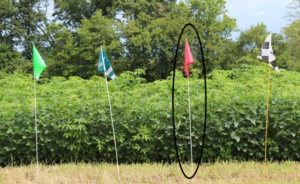By Jacy Lewis (April 2017)
It is common that growers may feel powerless when it comes to preventing herbicide drift into their vineyards, however there are actually a number of ways that winegrape growers can be proactive in protecting their vineyards from the effects of herbicide drift.
First and foremost start with your own pesticide program. This not only means in your vineyard but also on any property that you own surrounding your vineyard including your home, winery, or adjacent crops. Be certain that everyone who may care for any of these areas understands that there is a zero use policy for all synthetic auxin herbicides. This includes lawn and garden maintenance contractors. It is your responsibility to educate everyone working on your property about the dangers these synthetic auxin herbicides pose to your vineyard. It is surprising how many vineyards have experienced injury when the target plants were weeds on their own property, often applied by well meaning grounds keepers. This is the type of non-target injury that you have complete control over.
Another way to avoid injury is by networking and building relationships with anyone in your area who may be applying herbicides or interacts with individuals who do. If you have homes nearby, get to know your neighbors and let them know how dangerous these chemicals are for your vineyard. Because many homeowners are not fully aware of the nature of the herbicides they use in their lawn, provide them with a list of chemical and brand names to watch out for.
Contact your county commissioner or city and be certain they know that use of these chemicals in right of ways pose a serious threat to your vineyard operation, even when used according to label instructions. If you see someone spraying near your vineyard, don’t be afraid to politely ask them what they are spraying, if injury occurs this will arm you with needed information and they may even be willing to stop.
Get to know the chemical salesmen in your area. Be certain they are educated on the dangers these chemicals pose to your operation and ask them to please help you by educating buyers about these dangers as well. Having a congenial relationship with these salesmen can go a long way towards making them partners with you in educating consumers. Particularly in areas where winegrapes are not an established crop, many chemical applicators continue to be unaware of this danger and unaware that there are vineyards in their area.
Additionally, get to know the commercial applicators operating in your area. This includes landscape contractors as well as aerial applicators. Let them know the location of your vineyard as well as the damage that can be done to it from inadvertent drift. Be certain they are educated with regard to the volatility of some compounds and the distances from which they can pose a threat under certain weather conditions.
Finally, two new programs in Texas are designed to work in conjunction with one another to assist applicators in protecting non-target crops from accidental drift.
Flag the technology uses a system of colored flags to help applicators to visualize both resistant and susceptible crops both from the road and from above. Red flags are used to signify Extreme Caution; conventional varieties with no herbicidal resistance as well as apiaries, orchards, vineyards, vegetable fields, and organic crops. We recommend that as a precaution all growers participate in this system by marking their vineyards with these flags.

Red Flags are used to indicate highly sensitive crops like grapes. Photo courtesy of U. Missouri Extension
In conjunction with the Flag the technology program, the Hit the Target program that is replacing the Texas Crop Registry allows growers to register their sensitive crop acreages to be included in maps available to applicators. This program was advertised to go into effect on May 1st 2017.
The app can be found under the title “Flag the Technology” in your app store. It is available for both IPhone and Android devices.
While some growers are questioning the utility of the program, we feel it is important for growers to be proactive in taking all possible cautionary measures to protect their vineyards. Doing so might not only prevent accidental drift injury to your vineyards but may be important in showing regulators and courts that a grower has taken all possible protective action should an incident occur.